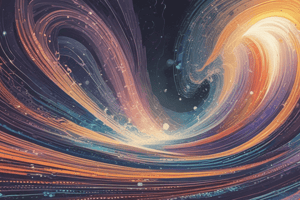Podcast
Questions and Answers
What is the definition of a wave?
What is the definition of a wave?
- A fixed pattern in space and time
- A disturbance that carries energy from one place to another (correct)
- A physical object that carries energy
- A type of electrical signal
What does monochromatic light primarily depend on?
What does monochromatic light primarily depend on?
- Its polarization
- Its wavelength (correct)
- Its intensity
- Its frequency
Which wave phenomenon can distinguish between transverse and longitudinal waves?
Which wave phenomenon can distinguish between transverse and longitudinal waves?
- Diffraction
- Reflection
- Polarisation (correct)
- Interference
What is constructive interference of waves?
What is constructive interference of waves?
How is destructive interference defined?
How is destructive interference defined?
What does the term dispersion of light refer to?
What does the term dispersion of light refer to?
Which type of waves cannot undergo polarisation?
Which type of waves cannot undergo polarisation?
What is wave-particle duality in relation to light?
What is wave-particle duality in relation to light?
What occurs during interference of waves?
What occurs during interference of waves?
What does the colour of light represent in relation to its wavelength?
What does the colour of light represent in relation to its wavelength?
What range of colours produced when light undergoes dispersion is called?
What range of colours produced when light undergoes dispersion is called?
Which of these is NOT a primary colour of light?
Which of these is NOT a primary colour of light?
What colour light results from mixing red, green, and blue lights in equal intensity?
What colour light results from mixing red, green, and blue lights in equal intensity?
Which of the following describes a secondary colour?
Which of the following describes a secondary colour?
What are complementary colours?
What are complementary colours?
In Young’s slits experiment, what does 'n' represent in the formula $n\lambda = d \sin \theta$?
In Young’s slits experiment, what does 'n' represent in the formula $n\lambda = d \sin \theta$?
What causes light to disperse in a prism?
What causes light to disperse in a prism?
Which electromagnetic wave has the shortest wavelength?
Which electromagnetic wave has the shortest wavelength?
How are longer wavelengths refracted compared to shorter wavelengths in a diffraction grating?
How are longer wavelengths refracted compared to shorter wavelengths in a diffraction grating?
What is the purpose of stress polarisation in materials?
What is the purpose of stress polarisation in materials?
What happens during the process of light dispersion?
What happens during the process of light dispersion?
Explain the significance of the path difference in interference patterns.
Explain the significance of the path difference in interference patterns.
How does polarisation affect the behaviour of transverse waves?
How does polarisation affect the behaviour of transverse waves?
Can longitudinal waves be polarised? Why or why not?
Can longitudinal waves be polarised? Why or why not?
What is meant by the term spectrum in the context of light?
What is meant by the term spectrum in the context of light?
How do interference and diffraction differ in their wave behavior?
How do interference and diffraction differ in their wave behavior?
Describe the impact of amplitude on constructive interference.
Describe the impact of amplitude on constructive interference.
What is the fundamental difference between transverse and longitudinal waves?
What is the fundamental difference between transverse and longitudinal waves?
How does wave-particle duality challenge classical physics?
How does wave-particle duality challenge classical physics?
What role does wavelength play in the color of monochromatic light?
What role does wavelength play in the color of monochromatic light?
What happens when two primary coloured lights are mixed in equal intensity?
What happens when two primary coloured lights are mixed in equal intensity?
Which secondary colours are formed from the mixing of primary colours of light?
Which secondary colours are formed from the mixing of primary colours of light?
How does refraction contribute to the dispersion of light in a prism?
How does refraction contribute to the dispersion of light in a prism?
What role does the collimator play in a spectrometer setup?
What role does the collimator play in a spectrometer setup?
What is the order of electromagnetic waves from shortest to longest wavelength?
What is the order of electromagnetic waves from shortest to longest wavelength?
In the context of light mixing, what is meant by complementary colours?
In the context of light mixing, what is meant by complementary colours?
What does stress polarization help to detect in materials?
What does stress polarization help to detect in materials?
How are the wavelengths of light varied in a diffraction grating?
How are the wavelengths of light varied in a diffraction grating?
Why is a rainbow considered a real-world example of light dispersion?
Why is a rainbow considered a real-world example of light dispersion?
What trigonometric relationship is fundamental in deriving Young’s slits formula?
What trigonometric relationship is fundamental in deriving Young’s slits formula?
Flashcards are hidden until you start studying
Study Notes
Wave Basics
- A wave is a disturbance that carries energy from one place to another.
- Light is a form of energy that travels via electromagnetic waves.
- Wave-particle duality describes light's ability to exhibit properties of both waves and particles.
Light Characteristics
- Monochromatic light consists of only one wavelength.
- The color of monochromatic light is determined by its wavelength.
Wave Phenomena
- Diffraction occurs when a wave spreads out as it passes through a gap or around an obstacle similar in size to its wavelength.
- Interference happens when two or more waves overlap, creating a new wave with altered amplitude.
- Polarization describes the alignment of vibrations in a transverse wave to a single plane.
Wave Types and Qualities
- Longitudinal waves cannot be polarized.
- Polarization can differentiate between transverse and longitudinal waves.
Interference Types
- Constructive interference results in a wave with greater amplitude than the original waves, associated with brightness. Occurs at path differences of 𝑛𝜆.
- Destructive interference produces a wave with smaller amplitude, correlating to darkness, occurring at path differences of (𝑛 + 1/2) 𝜆.
Light Dispersion
- Dispersion refers to the separation of light into its component wavelengths.
- A spectrum is the range of colors produced when light undergoes dispersion.
Color Theory
- The three primary colors of light are red, green, and blue.
- Mixing red, green, and blue light in equal intensity yields white light.
- Secondary colors result from mixing two primary colors in equal intensity, with examples including yellow, cyan, and magenta.
- Complementary colors consist of a primary and a secondary color whose mixture produces white light.
Young's Slits Experiment
- In the equation 𝒏𝝀 = 𝒅𝐬𝐢𝐧𝜽, the variable n represents the order of the diffracted image.
- Young’s slits formula can be derived using trigonometry, leading to the rearranged formula: 𝑛𝜆 = 𝑑 sin 𝜃.
Electromagnetic Waves
- The order of electromagnetic waves by increasing wavelength is: X-rays, Ultraviolet waves, Visible light, Radio waves.
- Light is dispersed through refraction in a prism.
- Longer wavelengths are refracted more than shorter wavelengths in diffraction gratings.
Real-world Applications
- A rainbow serves as a natural example of light dispersion.
- Stress polarization is utilized to check for material defects and inconsistencies.
Experimental Setup
- Terms like "collimator" and "two-slit screen" refer to specific components of optical experiments involving light measurement and observation.
Wave Basics
- A wave is a disturbance that carries energy from one place to another.
- Light is a form of energy that travels via electromagnetic waves.
- Wave-particle duality describes light's ability to exhibit properties of both waves and particles.
Light Characteristics
- Monochromatic light consists of only one wavelength.
- The color of monochromatic light is determined by its wavelength.
Wave Phenomena
- Diffraction occurs when a wave spreads out as it passes through a gap or around an obstacle similar in size to its wavelength.
- Interference happens when two or more waves overlap, creating a new wave with altered amplitude.
- Polarization describes the alignment of vibrations in a transverse wave to a single plane.
Wave Types and Qualities
- Longitudinal waves cannot be polarized.
- Polarization can differentiate between transverse and longitudinal waves.
Interference Types
- Constructive interference results in a wave with greater amplitude than the original waves, associated with brightness. Occurs at path differences of 𝑛𝜆.
- Destructive interference produces a wave with smaller amplitude, correlating to darkness, occurring at path differences of (𝑛 + 1/2) 𝜆.
Light Dispersion
- Dispersion refers to the separation of light into its component wavelengths.
- A spectrum is the range of colors produced when light undergoes dispersion.
Color Theory
- The three primary colors of light are red, green, and blue.
- Mixing red, green, and blue light in equal intensity yields white light.
- Secondary colors result from mixing two primary colors in equal intensity, with examples including yellow, cyan, and magenta.
- Complementary colors consist of a primary and a secondary color whose mixture produces white light.
Young's Slits Experiment
- In the equation 𝒏𝝀 = 𝒅𝐬𝐢𝐧𝜽, the variable n represents the order of the diffracted image.
- Young’s slits formula can be derived using trigonometry, leading to the rearranged formula: 𝑛𝜆 = 𝑑 sin 𝜃.
Electromagnetic Waves
- The order of electromagnetic waves by increasing wavelength is: X-rays, Ultraviolet waves, Visible light, Radio waves.
- Light is dispersed through refraction in a prism.
- Longer wavelengths are refracted more than shorter wavelengths in diffraction gratings.
Real-world Applications
- A rainbow serves as a natural example of light dispersion.
- Stress polarization is utilized to check for material defects and inconsistencies.
Experimental Setup
- Terms like "collimator" and "two-slit screen" refer to specific components of optical experiments involving light measurement and observation.
Studying That Suits You
Use AI to generate personalized quizzes and flashcards to suit your learning preferences.




